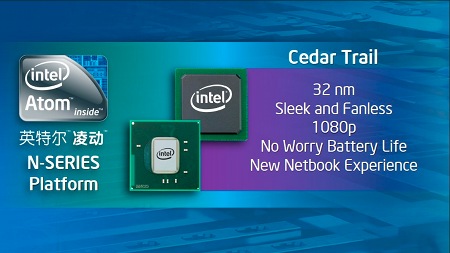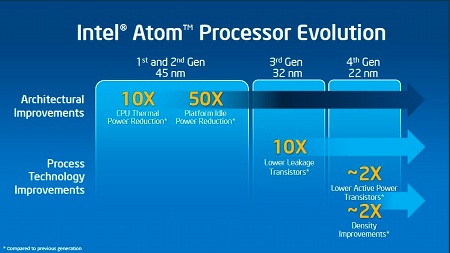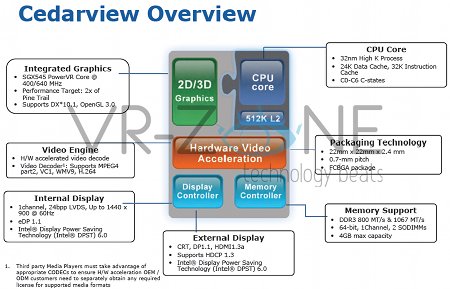Leaks reveal Intel’s shrinking Atoms
May 12, 2011 — by LinuxDevices Staff — from the LinuxDevices Archive — 3 viewsNew information is emerging about Intel's future Atom processors, which are downsizing in order to meet the power and space requirements of mobile devices. The 32nm “Cedar Trail” will ship later this year with enhanced PowerVR SGX545 graphics, HDMI and DisplayPort support, and the ability to use up to 4GB of DDR3 RAM, while the 22nm “Silvermont” will use Intel's 3-D Tri-Gate technology and ship in 2013, reports say.
Since the 2008 release of the original Z5xx ("Silverthorne"), Intel has released 42 different, 45nm-fabbed Atom processors (not including the Atom-based CE4100 and CE4200 systems-on-chip). Obviously pleased with their success, Intel is now in the process of shrinking the Atoms in order to save power (and help the processors fit inside small mobile devices).
Intel most recently released the "Oak Trail" Atom Z670, which is now being incorporated into a variety of tablets. Along with its SM35 Express I/O controller, this 45nm CPU is 50 percent smaller and 45 percent thinner than previous Atoms, and it offers devices "up to all-day battery life," according to the company.
But the chip giant has also tipped a smaller Atom platform code-named "Cedar Trail," which will shrink courtesy of 32nm fabrication, and, it's said, will go on sale during the second half of this year. Featuring further improvements in power consumption, "Cedar Trail" (below) will include Blu-ray 2.0 support, a dedicated media engine "for full 1080p playback," plus additional video options including Intel Wireless Display, DisplayPort, and HDMI, says Intel.

Intel's Cedar Trail
(Click to enlarge)
In a keynote at April's Intel Developer Forum in Beijing, Doug Davis, vice president and general manager of the Netbook and Tablet Group at Intel, discussed another 32nm Atom called "Cloverview." There's no word on how this might differ from Cedar Trail, but a slide in Davis' presentation suggested it's related to yet another 32nm variant: the "Medfield" version for smartphones. (We're guessing all three 32nm offerings have near-identical CPU cores and will be distinguished by application-specific I/O controllers.)

Intel's Atoms will shrink via 22nm fabrication
(Click to enlarge)
Meanwhile, another slide (above) in the Davis presentation promised that "fourth-generation" Atoms would shrink still further via 22nm fabrication. And when Intel announced its "Tri-Gate" 3-D transistors at the beginning of this month, it said the technology would also be used in future Atom processors and SoCs, including devices that will require less than 1mW of idle power.
More information breaks cover
Now, thanks to a pair of credible leaks, we have more information on both the 32nm and 22nm Atoms. Regarding the former, the VR-Zone website ran an "exclusive" story on May 10 with what appears to be a Intel-sourced graphic.

Intel's Cedarview platform
(Click to enlarge)
The slide (above) refers to the 32nm platform as "Cedarview," which we're assuming incorporates the Cedar Trail processor already mentioned above. According to the image, Cedarview will be a 22 x 22nm SoC that supports up to 4GB of DDR3 memory as well as LVDS displays up to 1440 x 900 pixels (plus external VGA, DisplayPort, or HDMI).
According to the graphic, Cedarview will also include PowerVR graphics IP licensed from Imagination Technologies, providing support for DirectX 10.1 and OpenGL 3.0, as well as hardware accelerated video decoding for MPEG-2, MPEG-4 part 2, VC1, WMV9, and H.264. Intel incorporated PowerVR graphics in its original Z5xx, but used its own graphics IP in many later Atoms. (This had the ironic result that the Z5xx is sometimes touted for its HD video decoding, whereas the later, popular N270 can't do HD in even the most fanciful copywriter's imagination.)
No information on power consumption or model numbers was provided in the VR-Zone story, but a posting earlier this month by AnandTech, which did not reveal its sources, offered convincing names and specs for the first two Cedar Trail CPUs. According to author Kristian Vättö, they'll both be dual-core: The Atom D2500 will be clocked at 1.86GHz, while the Atom D2700 will run at 2.13GHz (the fastest Atom ever).
Jonathan Angel can be followed at www.twitter.com/gadgetsense.
This article was originally published on LinuxDevices.com and has been donated to the open source community by QuinStreet Inc. Please visit LinuxToday.com for up-to-date news and articles about Linux and open source.